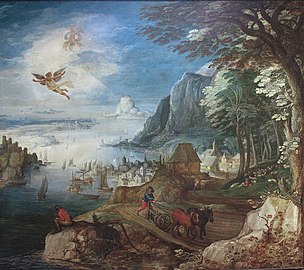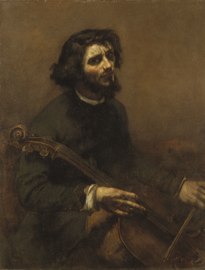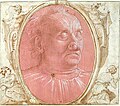Nationalmuseum
You can help expand this article with text translated from the corresponding article in Swedish. (August 2019) Click [show] for important translation instructions.
|
 The National Museum's facade | |
 Interactive fullscreen map | |
| Established | 1792/1866 |
|---|---|
| Coordinates | 59°19′43″N 18°4′40″E / 59.32861°N 18.07778°E |
| Type | National Gallery |
| Visitors | 122 133 (2017) |
| Director | Susanna Pettersson[1] |
| Website | nationalmuseum.se/en |
Nationalmuseum (or National Museum of Fine Arts) is the national gallery of Sweden, located on the peninsula Blasieholmen in central Stockholm.
The museum's operations stretches far beyond the borders of Blasieholmen, the nationalmuseum manage the National Portrait gallery collection at Gripshom, Gustavsbergporclain museum, a handful of castle collections and the Swedish Institute in Paris (Institut Tessin).[2] In the summer of 2018 Nationalmuseum Jamtli opened in Östersund as a way to show a part of the collection in the north of Sweden.[3]
The museum's benefactors include King Gustav III and Carl Gustaf Tessin. The museum was founded in 1792 as Kungliga Museet ("Royal Museum"). The present building was opened in 1866, when it was renamed the Nationalmuseum, and used as one of the buildings to hold the 1866 General Industrial Exposition of Stockholm.
The current building, built between 1844 and 1866, was inspired by North Italian Renaissance architecture. It is the design of the German architect Friedrich August Stüler, who also designed the Neues Museum in Berlin. The relatively closed exterior, gives no hint of the spacious interior dominated by the huge flight of stairs leading up to the topmost galleries.
The museum was enlarged in 1961 to accommodate the museum workshops. The present restaurant was instated in 1996. The museum building closed for renovation in 2013 and reopened on 13 October 2018. The $132 million overhaul sought to put more of the museum’s collection on display and to match the security, accessibility, fire safety and climate control of a modern institution.
History
The museum’s early history
As with several other European national galleries, the history of the Nationalmuseum is largely synonymous with the development from royally to state-owned, and by extension publicly available collections. In Sweden, the foundation was laid for today's state art collections in the 18th century. Several of the works included in the Nationalmuseum collection of, for example, 18th-century French paintings were once owned by Queen Lovisa Ulrika. In 1777, the Queen's financial situation became unsustainable, in part as a result of large-scale and costly collecting. The debts were settled by her son, Sweden's then King Gustav III, in exchange for her renouncing her collections and also Drottningholm palace.
The building

The project with a new Royal Museum in Stockholm was one of the largest and most lavish construction works of all time, which would take twelve years to complete and another three years to complete the interior work. The German architect Friedrich August Stüler was responsible for the design of the building and the Swedish architect Fredrik Wilhelm Scholander was responsible for the interior design. The building was inaugurated in 1866 at the same time as the Stockholm Exhibition in 1866. The Nationalmuseum has been a state building monument since 1935. The building is owned and managed by the National Property Board of Sweden.
Collection
The museum collection consists of about half a million drawings from the Middle Ages to 1900, a prominent 17th-century collection of Rembrandt and other Dutch painters, and a collection of porcelain items, paintings, sculptures, and modern art as well. In total the collection amounts to circa 700 000 objects. The museum also has an art library, open to the public and academics.
Nationalmuseum holds the largest collection of portrait miniatures in the world, with more than 5 200 works.[4] The collection features miniatures from many European school's, including works by Nicholas Hilliard, Isaac Oliver, Louis-Marie Autissier among others. A significant portion of works derives from the master collector Carl Fredrik Dahlgren, while the more exclusive works were donated by Hjalmar Wicander, a cork factory owner. Production of bottle corks for the brewery industry provided the basis of his fortune. Wicander also donated funds specifically for additional purchases of miniatures.[5]
Notable works
-
Giuseppe Arcimboldo, The Lawyer, possibly Ulrich Zasius, 1461-1536, humanist, jurist
-
Ludwig Refinger, Manlius Torquatus Fighting a Gaul
-
Rembrandt, Simeon's song of praise
-
Jacob Jordaens, The Holy family by candlelight
-
Judith Leyster, Boy playing the Flute
-
Marble busts in Room 1280, the Sculpture Courtyard.
-
Antoine Watteau, The love Lesson, c. 1716-1717
-
Jean Siméon Chardin, Rabbit and Copper Pot
-
Adolf Ulrik Wertmüller, Queen Marie Antoinette of France and two of her Children Walking in The Park of Trianon, 1785
-
Gustave Courbet,The Cellist (Self-portrait), 1847
-
Anders Zorn, Castles in the Air, 1885
-
Paul Gauguin, Fields by the Sea, 1889
-
Hanna Pauli, Frukostdags
-
Paul Cézanne, Still Life with Plaster Cupid
-
Vilhelm Hammershøi, Interior with a Reading Lady, c. 1900
Drawings
The collection of drawings contain c. 500 000 sheets, spanning from the late medieval period to about the year 1900.[6] The core being more than 2 000 old master drawings collected by Carl Gustaf Tessin. The sheets were acquired at the important sale of the court banker Pierre Crozat in the summer of 1741. Tessin was one of fourteen collectors who bought at bargain prices.[7] Because of financial reasons the collection had to be sold to king Adolf Fredrik.
-
Albrecht Dürer, Portrait of a Young Woman with Braided Hair, 1515
-
Domenico Ghirlandaio, Head of an Old Man, ca. 1490
-
Hendrick Goltzius, Self-Portrait, ca. 1590–91
"The new Nationalmuseum"

On the 3 of February 2013 the Nationalmuseum closed in preparation for renovation. The museum was in need of an extensive renovation and refurbishment as the building was worn by intensive use. In 2009, National Property Board of Sweden (SFV) was commissioned to carry out a feasibility study and in 2010 SFV was commissioned to produce a building program that was presented to the government in 2011. In 2012, planning began for renovation and rebuilding of the Nationalmuseum and in February 2013 the Nationalmuseum began its evacuation of the museum building.
One year later, on 20 February 2014, SFV was commissioned by the government to carry out renovation and conversion of the Nationalmuseum into a fully modern museum building, adapted to future museum operations with retained cultural-historical values in the unique, listed building. The work took place in close collaboration with the tenant Nationalmuseum.

During the renovation, the museum building itself on Blasieholmen was closed to the public. During the time when the museum building was closed, the Nationalmuseum continued to show its art collection in other places in Stockholm, Sweden and abroad.
The museum was reinaugurated on 13 October 2018 by King Carl XVI Gustaf in the presence of parts of the royal family, Minister of Culture Alice Bah Kuhnke and thousands of visitors . The museum's exhibition space has been expanded and can now receive twice as many visitors and display almost three times as many works. In addition to a technical update, previously clogged windows and ceiling lanterns have been taken up to create more daylight and views of the city. The noisy restaurant has been given a better, quieter location and replaced with an airy and quiet sculpture courtyard. The museum has regained a rich color scheme inspired by the original colour palette.
See also
References
- Johan Mårtelius (1999). "Norra innerstaden". Guide till Stockholms arkitektur (2nd ed.). Stockholm: Arkitektur Förlag AB. p. 67. ISBN 91-86050-41-9.
- ^ da Silva, Tali; Grönberg, Anna (21 March 2018). "Susanna Pettersson blir ny chef på Nationalmuseum" (in Swedish). SVT Nyheter. Retrieved 13 October 2018.
- ^ "Nationalmuseum collection placement". www.nationalmuseum.se/. 2 July 2021.
{{cite web}}: CS1 maint: url-status (link) - ^ "Nationalmuseum Jamtli". www.jamtli.com/. 7 July 2021.
{{cite web}}: CS1 maint: url-status (link) - ^ "Portrait miniature at Nationalmuseum". www.nationalmuseum.se/. 12 July 2021.
{{cite web}}: CS1 maint: url-status (link) - ^ "About the collection". www.nationalmuseum.se/en/. 12 July 2021.
{{cite web}}: CS1 maint: url-status (link) - ^ "Nationalmuseum drawings and graphics". www.nationalmuseum.se/. 2 July 2021.
{{cite web}}: CS1 maint: url-status (link) - ^ "Tessin collection of drawings". www.themorgan.org/. 2 July 2021.
{{cite web}}: CS1 maint: url-status (link)
External links
- National Museum of Fine Arts
- Virtual tour of the Nationalmuseum provided by Google Arts & Culture
 Media related to Nationalmuseum Stockholm at Wikimedia Commons
Media related to Nationalmuseum Stockholm at Wikimedia Commons

























